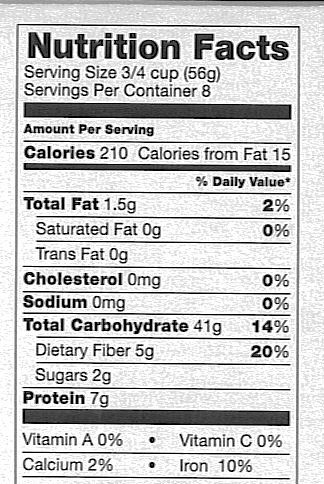Nutrition Labeling
 At your grocery, one of the most beneficial things you can do to assure your weight loss success is to read the Nutrition Labels of the foods you consider buying. Let's talk a little about the kind of information that these labels provide.
At your grocery, one of the most beneficial things you can do to assure your weight loss success is to read the Nutrition Labels of the foods you consider buying. Let's talk a little about the kind of information that these labels provide.
The example shown here is from a box of whole wheat penne pasta. The first thing to notice is the definition of Serving Size since all the other information is related to 1 serving. Here we see that 1 serving of this pasta is 3/4 cup. It also tells us that there should be approximately 8 servings in this box of pasta. All the other information is based upon 1 serving, so if you eat 1 serving of this pasta, you will consume 210 calories and 15 of those calories are from fat.
As we continue looking at the label we see the content of Fat, Cholesterol, Sodium, Carbohydrate and Protein. Two of the kinds of fats are listed separately, Saturated Fat & Trans Fat. These are the two kinds of fat that you should avoid as much as possible because of their association with heart disease. In this example they are 0, so we know that the other kinds of Fat, Monounsaturated or Polyunsaturated must account for the 1.5 grams that are contained in this food. Another positive for this food is the absence of Cholesterol & Sodium. The Carbohydrate content is somewhat high at 41 grams. (If you use the Dietary Nutrient Assessment Tool in the Nutrition Tools section of this website, you will see that for a 1200 calorie mealplan the recommended Carbohydrate intake is approximately 150 grams.) That 3/4 cup contains a lot of complex carbohydrates, since the Dietary Fiber and Sugar components are relatively small at 5 and 2 grams respectively. For a person who has an elevated amount of triglycerides in their blood, lowering their Carbohydrate intake may also improve their triglyceride level.
Finally, you can see that the Protein content is 7 grams and that this pasta contains some Calcium & Iron. The percentages that you see are the percentages of the daily recommended values where known for each of these for someone on a 2000 calories mealplan. So, since your mealplan is less than 2000 calories, these amounts actually represent a greater percentage of the recommended amounts for you.
Using Nutritional Information
Comparing nutrition labels is most helpful in choosing between one or more similar products or among brands of the same food. If you have high blood pressure or heart failure, you should minimize your sodium intake, so you can use the information on the Nutrition Labels to choose foods with lower Sodium content. If you have a high level of cholesterol in your blood, use the information to choose those foods lower in Cholesterol, Saturated Fat and Trans Fat to lower your blood cholesterol as well as your risk for heart attack and stroke.
You can get much of the nutrition information for over 6,000 foods right in the comfort of your home without having to go to your grocery. The Nutritional Content Calculator on the Nutritional Tools section of this website will allow you to look up the nutritional information for many of the foods you are considering. Just follow the Nutrition Tools link here or in the navigation bar above and click on the Nutritional Content Calculator. You'll then have a chance to choose a food and follow a few simple steps to see its nutritional content. You can even create a temporary list of foods and then download the list to your computer as a spreadsheet.
Other Food Buying Tips
Shopping smart starts with planning. Before you go to the grocery, make a list of the foods you need to get. The grocery list that we give you with your meal plan is a great place to start. By sticking to the list you will avoid making poor food choices.
Another tip is to avoid going food shopping when you are hungry. You are more likely to impulsively buy high caloric, unhealthy "junk" foods then. So take your list after you've had a meal, and you'll be more likely to make healthier food choices.
In the next module, we'll look at the importance of exercise in your weight loss plan. In the meantime, use the Practice Tests to learn this information.
